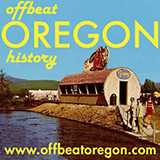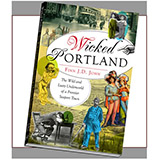RUMINATION
Centennial Farewell
Oregon's loss of innocence and search for its true identity in the 50 years after 1959
By FINN J.D. JOHN
February 2010
In 1959, the state of Oregon celebrated its 100-year anniversary with a massive state-wide celebration. Confident and progressive in tone, Oregon’s centennial was the reflection of a people who knew who they were and what the future held – a people with big plans and no reason to think they would not come to fruition.
Well, it’s been half a century, and we just wrapped up the sesquicentennial on Valentine’s Day this year. But this celebration seemed much more timid. Very little money was spent on it. Most Oregonians didn’t even notice it.
Why such a difference?
I think the fundamental reason is, Oregon doesn’t really know itself any more. Oregon is changing radically – and has been since the early 1980s.
But changing into what? What are we becoming? Does anyone really know? I don’t.
* * *
I wasn’t alive in 1959. But the era that year highlighted lasted long enough for me to experience its spirit growing up in the early 1970s. We lived in a forest so dark and green it almost seemed primordial, along Table Rock Creek (pronounced “crick”) deep in the foothills of the Cascades. If you left our driveway and turned right, you’d reach a dead-end at Wilhoit Springs, with thickly forested hills rising all around. If you turned left, you’d reach the tiny logging town of Molalla (pronounced “MO-lala”) after about 10 minutes of driving.
Back then, Molalla was known for two things: The Buckaroo rodeo, and timber. There were at least four huge mills clustered around its outskirts – one that cut lumber, one that peeled veneer and made plywood, several more that did I-don’t-know-what. They all seemed to run 24 hours a day. Molalla was noisy and busy all the time. Tall yellow straddle trucks loaded with units of two-by-fours, painted Caterpillar yellow, swarmed like bees around one of the sawmills and occasionally went on forays across town. Log trucks rumbled through town, sometimes loaded with just a single massive old-growth log. Shift workers, loggers and rodeo cowboys drove around town in modified four-by-four pickups, looking tough and prosperous, sporting black baseball caps with “CAT Diesel Power” emblazoned in dark-yellow letters above the bill. High school kids practiced bootlegger reverses in intersections around town, driving powerful Camaros and Mustangs and Challengers that they’d bought with the money they’d earned working in the mill over summer vacation. Sometimes they’d misjudge their speed and end up wrapped around a power pole. No big deal; there was always next summer, when a few months of pulling green chain in the mill would raise enough cash to fix the car or even buy a new one.
I collected bottle caps, as so many kids did, so I had a pretty good idea of what Molalla was drinking. Molalla loved Olympia Beer. Rainier was a distant second, followed by Hamm’s, Blitz-Weinhard and Lucky Lager. A Budweiser cap was a rare treasure – much less common than one from a bottle of Pabst, Schlitz Malt Liquor or Heidelburg.
Most of our neighbors didn’t give a second thought to the environment. It was everywhere, huge and abundant and seemingly inexhaustible. They loved to be out in it, and most were careful not to spoil its beauty by littering, but they didn’t worry about its health. They drained their cars’ oil sumps into the ground, let their livestock walk in the creek, tore through boggy meadows in their four-wheel-drives. But they meant no harm – and never considered that they might be doing any.
Time went by. We moved first to Beaverton, then to southeast Portland. Now we were living in places where people weren’t so sure of who they were. I remember the east side of Portland in the 1980s as relentlessly gray – its sky, its streets, its buildings. Still, people weren’t that much different from our old neighbors in Molalla. They worked, drank bad coffee and cheap beer and drove modest but new Chevrolets. They did listen to different music, though.
Then came the Spotted Owl controversy. It split the state cleanly in two – those who made a living cutting and processing lumber and those who didn’t. Meanwhile, people attracted by the state’s scenery and climate started to move in from other states – especially California. The newcomers were more urbane and sophisticated, and many of them lost no time in working to change the state to better suit their vision of what it ought to look like. People who were already there – already under stress because of the imploding timber economy – grew resentful. Many blamed the disappearance of the Oregon of 1959 on the incoming hordes of well-heeled Californians, and to blame the layoffs at the sawmills – largely driven by mechanization – on the spotted owl.
The newcomers brought more refined tastes and interests with them. A whole new industry of micro-brewing developed even as the major local brewers died off – nobody was drinking cheap stubby bottles of Blitz or Oly any more. In 1975, you could have counted the espresso bars in Oregon on one hand, even if you’d lost a finger or two in the woods. Today, there are thousands, and Oregon is full of people who simply won’t drink regular coffee. In 1975, very few people drove European cars and those who did were mostly hippies or quirky intellectual types; ten years later, I could tell how close I was to an urban center by the ratio of BMWs to four-wheel-drive pickups on the road.
By the late 1980s, few people in the state could tell you what Oregon culture was. Or, rather, everyone could. Every person in the state seemed to have a different vision.
Much of the country seemed to consider Oregon the Vermont of the West Coast, so a lot of newcomers came to the state prepared to see that in it. Was that the state’s future? A woodsy refuge for agro-hippies living side by side with “straights” in a spirit of mutual tolerance and good-will?
Old-time residents were still in denial – it had been less than 10 years since the good times ended. Many still hoped the state would come to its senses and bring those good times back. Was that the state’s future? A return to 1959, with roaring mills and plenty of work, new cars, boats on the lakes, friendly neighbors?
A far-out guru from India had come to the state and established something that looked, from afar, disturbingly like a little dystopic regimented society in northern central Oregon. Would that sort of thing be part of the state’s future, too? Miniature Gattacas?
It was becoming clear that Oregon was not so much evolving into something new, as evolving out of something old. Philosophies that had defined the state for decades were starting to lose their power. The state legislature started scaling back Willamette Valley fieldburning drastically. More and more people had started questioning logging practices – advocating changes ranging from sensible reforms such as skyline yarding to radical proposals to stop all logging. The Kipling-esque myth of benevolent settlers bringing Christianity to the benighted and grateful “Flathead Indians” had long since turned sour and been replaced with uncomfortable silence.
The huge self-portrait that Oregonians had once mostly agreed upon – the spirit of the centennial, of Progress, of bright and sunny visions of a shared and golden future full of trees and salmon and sacks of grass seed – was disintegrating into a kind of frightening and apparently random mosaic of tiny, disconnected visions. And the only thing most people agreed on was what we were not – and what we no longer were.
I saw an ad in Advertising Age back in 1992 that seemed to sum this up. It was an ad for Portland, trying to present the town as a modern and cosmopolitan city; Weiden+Kennedy had paid for it, apparently worried that Oregon’s rustic, cork-booted image was bad for business. In it, two edgy-but-stylish twenty-something women were walking on a well-scrubbed downtown sidewalk in front of a snappy-looking skyscraper. The caption read, with exquisite sarcasm, “Yeah, we’re all lumberjacks here.”
No, Oregon wasn’t exclusively a timber park any more. But what was it? On this, the ad was silent.
* * *
Just a few weeks ago, we officially closed the door on Oregon’s sesquicentennial year. And today, the state has changed so much that a Rip Van Winkle character from 1959 would probably not recognize it.
The “timber wars” have matured into the “urban-rural divide” that we heard so much about during the recent elections over Measure 66 and 67. Timber families, on the ropes for years as the wheels came off their industry, have adjusted to the new environment, but they have not forgotten the fight – nor have they forgotten who, as they see it, brought it to them.
The passage of Ballot Measure 5, back in 1990, cut government off from one of its primary revenue sources, prompting the state to find dozens of new tiny revenue streams – day-use fees at parks, traffic-ticket surcharges, a canoe paddling permit. Each must be administered and enforced. After decades of plentiful money from timber sales, Oregonians are now having to pay for their government. Today, we do so in this uniquely inefficient way, and we are subjected to a far greater amount of government intrusion and regimentation as a result.
An electoral fight continues to rage over development rights to property, pitting those who want to subdivide their property and sell it off against those who want to prevent urban sprawl. Opposing parties in this debate are barely on speaking terms. Someday, one side or the other will probably “win,” and this alone will have a huge impact on whom we become.
Oregon is not finished changing. Its population continues to climb every year, especially in the Willamette Valley. We don’t live in a mature society. We didn’t in 1959 either – we just thought we did. Someday, dozens of years from now, when the population stabilizes and there is no longer a need to fight over resources, Oregonians will look around and say, “This is my state; this is my culture” in the way you might if you were a Tuscan walking through your ancient hilltop city one Sunday morning. Until then, though, most of us will have to get used to cultural confusion.
The Oregon of 1959 was familiar, and comforting, and empowering to most of us. But it was an illusion, built on the mistaken idea that nature would always provide as much as we might need – enough deer and salmon for us to hunt, enough timber for us to cut, enough water and air to dilute the poisons drifting downstream and downwind from our paper mills. It was a lovely time to be an Oregonian. It ended – it had to end. Pining after it won’t bring it back. But maybe, someday, after we’ve all gotten used to one another again and forged a lasting peace with our land, we’ll join together and make a new Oregon that’s half as good as the dream we once lived in.






